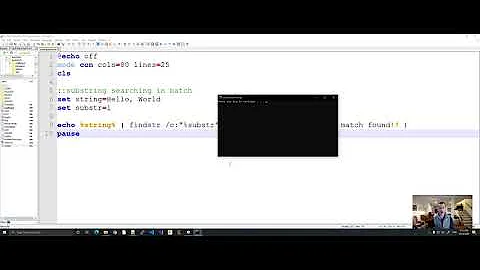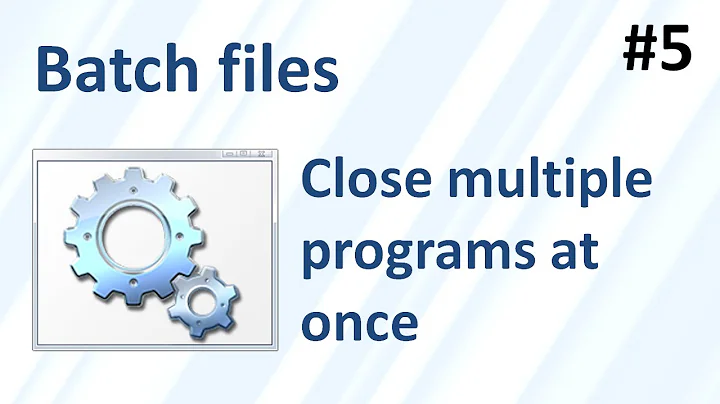How do I escape ampersands in batch files?
Solution 1
From a cmd:
-
&is escaped like this:^&(based on @Wael Dalloul's answer) -
%does not need to be escaped
An example:
start http://www.google.com/search?client=opera^&rls=en^&q=escape+ampersand%20and%20percentage+in+cmd^&sourceid=opera^&ie=utf-8^&oe=utf-8
From a batch file
-
&is escaped like this:^&(based on @Wael Dalloul's answer) -
%is escaped like this:%%(based on the OPs update)
An example:
start http://www.google.com/search?client=opera^&rls=en^&q=escape+ampersand%%20and%%20percentage+in+batch+file^&sourceid=opera^&ie=utf-8^&oe=utf-8
Solution 2
& is used to separate commands. Therefore you can use ^ to escape the &.
Solution 3
You can enclose it in quotes, if you supply a dummy first argument.
Note that you need to supply a dummy first argument in this case, as start will treat the first argument as a title for the new console windows, if it is quoted. So the following should work (and does here):
start "" "http://www.google.com/search?client=opera&rls=en&q=escape+ampersand&sourceid=opera&ie=utf-8&oe=utf-8"
Solution 4
explorer "http://www.google.com/search?client=opera&rls=...."
Solution 5
The command
echo this ^& that
works as expected, outputing
this & that
The command
echo this ^& that > tmp
also works, writing the string to file "tmp". However, before a pipe
echo this ^& that | clip
the ^ is interpreted completely differently. It tries to write the output of the two commands "echo this" and "that" to the pipe. The echo will work then "that" will give an error. Saying
echo this ^& echo that | clip
will put the strings "this" and "that" on the clipboard.
Without the ^:
echo this & echo that | clip
the first echo will write to the console and only the second echo's output will be piped to clip (similarly for "> tmp" redirection). So, when output is being redirected, the ^ does not quote the & but instead causes it to be applied before the redirection rather than after.
To pipe an &, you have to quote it twice
echo this ^^^& that | clip
If you put the string in a variable
set m=this ^& that
then
set m
will output
m=this & that
but the obvious
echo %m%
fails because, after Windows substitutes the variable, resulting in
echo this & that
it parses this as a new command and tries to execute "that".
In a batch file, you can use delayed expansion:
setlocal enableDelayedExpansion
echo !m!
To output to a pipe, we have to replace all &s in the variable value with ^&, which we can do with the %VAR:FROM=TO% syntax:
echo !m:^&=^^^&! | clip
On the command line, "cmd /v" enables delayed expansion:
cmd /v /c echo !m!
This works even when writing to a pipe
cmd /v /c echo !m! | clip
Simple.
Related videos on Youtube
Peter Mortensen
Experienced application developer. Software Engineer. M.Sc.E.E. C++ (10 years), software engineering, .NET/C#/VB.NET (12 years), usability testing, Perl, scientific computing, Python, Windows/Macintosh/Linux, Z80 assembly, CAN bus/CANopen. Contact I can be contacted through this reCAPTCHA (requires JavaScript to be allowed from google.com and possibly other(s)). Make sure to make the subject specific (I said: specific. Repeat: specific subject required). I can not stress this enough - 90% of you can not compose a specific subject, but instead use some generic subject. Use a specific subject, damn it! You still don't get it. It can't be that difficult to provide a specific subject to an email instead of a generic one. For example, including meta content like "quick question" is unhelpful. Concentrate on the actual subject. Did I say specific? I think I did. Let me repeat it just in case: use a specific subject in your email (otherwise it will no be opened at all). Selected questions, etc.: End-of-line identifier in VB.NET? How can I determine if a .NET assembly was built for x86 or x64? C++ reference - sample memmove The difference between + and & for joining strings in VB.NET Some of my other accounts: Careers. [/]. Super User (SU). [/]. Other My 15 minutes of fame on Super User My 15 minutes of fame in Denmark Blog. Sample: Jump the shark. LinkedIn @PeterMortensen (Twitter) Quora GitHub Full jump page (Last updated 2021-11-25)
Updated on February 19, 2021Comments
-
 Peter Mortensen about 3 years
Peter Mortensen about 3 yearsHow do I escape ampersands in a batch file (or from the Windows command line) in order to use the
startcommand to open web pages with ampersands in the URL?Double quotes will not work with
start; this starts a new command-line window instead.Update 1: Wael Dalloul's solution works. In addition, if there are URL encoded characters (e.g. space is encoded as %20) in the URL and it is in a batch file then '%' must be encoded as '%%'. This is not the case in the example.
Example, from the command line (
CMD.EXE):start http://www.google.com/search?client=opera&rls=en&q=escape+ampersand&sourceid=opera&ie=utf-8&oe=utf-8will result in
http://www.google.com/search?client=operabeing opened in the default browser and these errors in the command line window:
'rls' is not recognized as an internal or external command, operable program or batch file. 'q' is not recognized as an internal or external command, operable program or batch file. 'sourceid' is not recognized as an internal or external command, operable program or batch file. 'ie' is not recognized as an internal or external command, operable program or batch file. 'oe' is not recognized as an internal or external command, operable program or batch file.Platform: Windows XP 64 bit SP2.
-
william about 12 yearsWhat about plus sign
+what should I put in front to escape it? -
 phuclv almost 7 yearsIn PowerShell
phuclv almost 7 yearsIn PowerShellstart "http://www.google.com/search?client=opera&rls=en&q=escape+ampersand&sourceid=opera&ie=utf-8&oe=utf-8"works because PowerShell will strip quotes out
-
-
 Peter Mortensen over 14 yearsOK, I will admit the title does not completely match the question inside. (Do you think I should make the title longer?)
Peter Mortensen over 14 yearsOK, I will admit the title does not completely match the question inside. (Do you think I should make the title longer?) -
belugabob over 14 yearsNot so 'Doh', after all - enclosing in quotes was the right idea - just didn't know about the console window title thing. Thanks Johannes!
-
william about 12 yearsWhat about plus sign
+what should I put in front to escape it? -
 Peter Mortensen over 10 yearsThis is the more general applicable solution. It also works if a parameter of a command-line program has one or more ampersands in it. I just encountered this - the parameter was CGW5COMM&10C4&8301.
Peter Mortensen over 10 yearsThis is the more general applicable solution. It also works if a parameter of a command-line program has one or more ampersands in it. I just encountered this - the parameter was CGW5COMM&10C4&8301. -
Derek Greer over 9 yearsQuoting an ampersand with the caret character ^ doesn't seem to work in all circumstances. For example, attempting to execute msdeploy.exe with the /p: switch to pass a password with an ampersand doesn't seem to work with any permutation I've tried (caret quote, double quotes, dummy first argument).
-
 jpmc26 over 9 yearsAn example of using
jpmc26 over 9 yearsAn example of using^would be invaluable. -
Lasse Christiansen over 9 years@jpmc26 I have added an example in this answer.
-
 Peter Mortensen over 9 yearsIt could also include an example of escaping "%" - then I can clean up my question.
Peter Mortensen over 9 yearsIt could also include an example of escaping "%" - then I can clean up my question. -
Lasse Christiansen over 9 years@PeterMortensen Definitely - I have updated my answer.
-
 liquide over 8 yearsWhich characters should I also escape? I noticed that I have to escape "|" by "^|".
liquide over 8 yearsWhich characters should I also escape? I noticed that I have to escape "|" by "^|". -
jeb about 8 yearsYour solution for pipes works, but your conclusions are more or less wrong. Btw. a simple
echo this ^^^& that | clipworks too. To understand the magic pipe handling you could read SO: Why does delayed expansion fail when inside a piped block of code? -
 phuclv almost 7 yearsPowerShell will strip quotes from the arguments, so this will fail. You need to use only
phuclv almost 7 yearsPowerShell will strip quotes from the arguments, so this will fail. You need to use onlystart "http://www.google.com/search?client=opera&rls=en&q=escape+ampersand&sourceid=opera&ie=utf-8&oe=utf-8"on PowerShell -
 Peter Mortensen over 5 yearsA more general treatment of this subject is in A Better Way To Understand Quoting and Escaping of Windows Command Line Arguments, How a Windows Program Splits Its Command Line Into Individual Arguments, and How Command Line Parameters Are Parsed.
Peter Mortensen over 5 yearsA more general treatment of this subject is in A Better Way To Understand Quoting and Escaping of Windows Command Line Arguments, How a Windows Program Splits Its Command Line Into Individual Arguments, and How Command Line Parameters Are Parsed. -
 Peter Mortensen over 5 yearsE.g from the second source: "The way cmd.exe interprets the command line is different and completely independent of how an executable program interprets the command line."
Peter Mortensen over 5 yearsE.g from the second source: "The way cmd.exe interprets the command line is different and completely independent of how an executable program interprets the command line." -
 Peter Mortensen over 5 years
Peter Mortensen over 5 years^does not work for escaping%. Use%instead:%% -
 Jeremy over 5 years@PeterMortensen the recaptcha link in your profile is dead
Jeremy over 5 years@PeterMortensen the recaptcha link in your profile is dead -
TamaMcGlinn about 4 yearsIn this case
%does not need to be escaped, because who would be silly enough to define20andas an environment variable? If you did,start http://www.google.com/search?q=ampersand%20and%20percentagecould link tohttp://www.google.com/search?q=ampersandsomething-silly20percentageinstead. Using^%to escape in cmd, the example works as expected. -
 tripleee about 3 yearsNot my downvote, but this seems to duplicate a couple of older answers, both with more details and explanations.
tripleee about 3 yearsNot my downvote, but this seems to duplicate a couple of older answers, both with more details and explanations.







